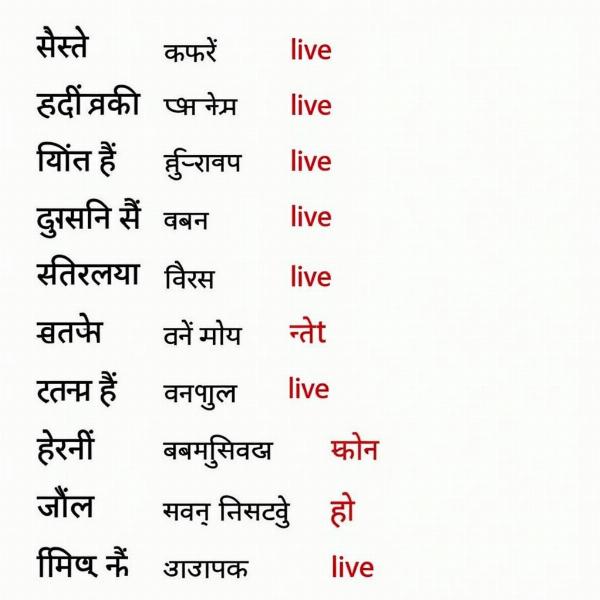Understanding the meaning of “live” in Hindi can be tricky, as it encompasses a range of concepts depending on the context. Are you talking about live music, a live broadcast, or simply the act of living? This article will explore the various Hindi translations of “live,” providing you with a comprehensive understanding of this multifaceted word.
Understanding the Different Meanings of “Live”
The English word “live” has several meanings, and each translates differently in Hindi. Here’s a breakdown of the most common interpretations and their corresponding Hindi translations:
-
To be alive/living: The most basic meaning of “live” refers to the state of being alive. In Hindi, this is most commonly translated as ज़िंदा (zinda). You might use this word to describe a person, animal, or even a plant. For example, “The fish is still live” translates to “मछली अभी भी ज़िंदा है (machhli abhi bhi zinda hai).” Another common word is जीवित (jeevit) which is more formal and often used in literature.
-
To reside/dwell: “Live” can also mean to reside somewhere. The Hindi translation for this meaning depends on the context. रहना (rahna) is a common verb meaning “to stay” or “to live.” For instance, “I live in Delhi” translates to “मैं दिल्ली में रहता हूँ (main Dilli mein rahta hun).” For a more permanent sense of residence, you might use बसना (basna), which implies settling down.
-
Live broadcast/performance: In the context of a live broadcast or performance, the Hindi word सीधा प्रसारण (seedha prasaran) is used. This emphasizes the real-time nature of the event. For example, “a live concert” would be “एक सीधा प्रसारण संगीत कार्यक्रम (ek seedha prasaran sangeet karyakram).” Sometimes, लाइव (laiv) – the transliteration of the English word – is also used, especially in informal contexts.
-
Live wire/electric current: When referring to a live wire, the Hindi word जीवंत तार (jeevant taar) or विद्युत प्रवाहित तार (vidyut pravahit taar) is used to highlight the presence of an electric current.
Live vs. Recorded: ज़िंदा (Zinda) and रिकॉर्ड किया हुआ (Recorded)
The difference between a live and recorded event is crucial. In Hindi, the distinction is clear. A “live” event happens in real-time, while a “recorded” event is captured and can be viewed later. For example, a live news broadcast (सीधा प्रसारण समाचार (seedha prasaran samachar)) is happening at that very moment, whereas a recorded program (रिकॉर्ड किया हुआ कार्यक्रम (recorded kiya hua karyakram)) can be watched anytime.
Using “Live” in Different Contexts: Examples and Phrases
Here are some examples illustrating the usage of “live” in different contexts and their corresponding Hindi translations:
- They live a simple life: वे एक साधारण जीवन जीते हैं (ve ek sadharan jeevan jeete hain).
- Long live the king!: राजा दीर्घायु हों! (Raja dirghayu hon!)
- Live and let live: जीयो और जीने दो (Jiyo aur jeene do).
- Where do you live?: आप कहाँ रहते हैं? (Aap kahan rahte hain?)
How to Say “Live Life to the Fullest” in Hindi
“Living life to the fullest” emphasizes experiencing life with enthusiasm and taking advantage of every opportunity. In Hindi, this sentiment can be expressed in several ways:
- अपने जीवन का पूरा आनंद लें (apne jeevan ka pura anand len): Enjoy your life to the fullest.
- हर पल को जियो (har pal ko jiyo): Live every moment.
- ज़िंदगी को भरपूर जियो (zindagi ko bharpur jiyo): Live life abundantly.
Conclusion: Understanding “Live” in Hindi
 Understanding the meaning of "live" in Hindi
Understanding the meaning of "live" in Hindi
Understanding the nuances of “live” in Hindi enriches your grasp of the language and allows for more accurate and effective communication. Remember to consider the context to choose the most appropriate translation. Whether you’re talking about the state of being alive, a place of residence, or a real-time event, this article has provided you with the essential vocabulary to express yourself clearly.
FAQ:
- What is the most common Hindi word for “live” (alive)? ज़िंदा (zinda) is the most common word for “alive.”
- How do you say “live broadcast” in Hindi? सीधा प्रसारण (seedha prasaran) is the term for “live broadcast.”
- What is the difference between रहना (rahna) and बसना (basna)? रहना (rahna) means “to stay” or “live” temporarily, while बसना (basna) implies permanent settlement.
- Can I use लाइव (laiv) for “live”? Yes, लाइव (laiv) is commonly used, especially in informal settings, but सीधा प्रसारण (seedha prasaran) is more formal.
- How do you say “live music” in Hindi? लाइव संगीत (laiv sangeet) or सीधा प्रसारण संगीत (seedha prasaran sangeet) are commonly used for “live music.”
Meaning-Hindi.in is your one-stop solution for all your Hindi translation needs. We offer a wide range of translation services, including business and commercial document translation, certified and legal document translation, technical and user manual translation, website and localization translation, educational and academic document translation, and fast and urgent translation services. Our team of expert Hindi linguists ensures accurate and culturally sensitive translations, catering to a diverse clientele. Contact us today at [email protected] or call us at +91 11-4502-7584 to discuss your translation requirements. Meaning-Hindi.in is committed to delivering high-quality, professional translations that bridge the language gap.